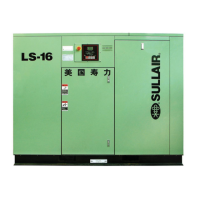Section 7
MAINTENANCE
44
TROUBLESHOOTING -- SUPERVISOR II (CONTINUED)
SYMPTOM (DISPLAY) PROBABLE CAUSE REMEDY
COMPRESSOR DOES NOT Air Demand Exceeds Supply Check air service lines for open
BUILD FULL DISCHARGE valves or leaks.
PRESSURE
Inlet Air Filter Clogged Check for maintenance message
on Supervisor display. Inspect and/or
change element.
Inlet Valve Not Fully Open Check actuation and position.
Pressure Sensor and/or Connections Check connections from trans--
at Fault ducer. If adequate, replace trans--
ducer.
LINE PRESSURE RISES ABOVE Pressure Sensor P2 at Fault Check connections from trans--
UNLOAD SETTING ducer. If adequate, replace
transducer.
Unloading Device (i.e., Blowdown Check operation of unloading device.
Valve) Failed to Operate
Solenoid Valve Failed Check operation of solenoid
to Operate valve.
Control Air Signal Leaks Check tubework feeding control
signal for leaks.
Control Air Signal Filter Clogged Service filter assembly.
EXCESSIVE FLUID CONSUMPTION Damaged or Improperly Gasketed Inspect separator element and
Separator Element gasket. Replace if damaged.
Fluid System Leaks Check tube/pipework for leaks.
Fluid Level Too High Drain excess fluid.
Excessive Fluid Foaming Drain and change fluid.
LIQUID WATER IN COMPRESSED Water Vapor Condensation From Cooling Remove the water vapor from compressed
AIR LINES and Compression Occurs Naturally air prior to distribution through the air system.
Check operation of aftercooler and moisture
separator. Install a compressed air dryer sized
for the flow and dryness level required. (Note:
Filters may also be required to remove
particulates, liquid oil aerosols or for oil vapor
removal. Change cartridges as recommended
by the filter manufacturer). Check all drain traps
routinely to insure their proper operation. Main--
tain them regularly.
NOTE ON TRANSDUCERS:
Whenever a sensor is suspected of fault, the recom-
mended cause of action is to measure the signal
(pressure, temperature, etc.) with an alternate cali-
brated instrument and compare readings. If readings
conflict, the electrical and/or tubing connections
should beinspected, and if no faults are evident, then
replace the sensor and re--evaluate against the cali-
brated instrument.
7.11 CALIBRATION
The Supervisor II has software calibration of the
pressure and temperature probes. This calibration
affects the offset but not the slope of the pressure
and temperature calculations. Because of this, the
most accurate method is to heat or pressurize the
transducer to its operating value. If thisis too difficult,
room temperature/open atmosphere calibration is
adequate. Calibration may only be done while ma-
chine is stopped and unarmed.
To enter calibration mode, you must press the follow-
ing keys in sequence while in the default status dis-
play mode: “
”
,
“
Y
”
,DSP,
“
B
”
,PRG
.Oncein
calibration mode, you will see a screenlikethefollow-
ing:
CAL P1
970
In the above example, “0” refers to the amount of ad-
justment (in psi or
_
F, “97” refers to the current value
of P1).
To make adjustments, Press the “
Y
” (UP ARROW)
key to increase the value, press the “
B
”(DOWN
ARROW / LAMP TEST) key to decrease the value.
The number on the left will increase or decrease al-

